The Messy Heart of London Drag Still Beats in Sink The Pink Nightclub
Credit to Author: Ben Charlie Smoke| Date: Thu, 11 Apr 2019 18:31:14 +0000
Eleven years ago, best friends Amy Zing and Glyn Fussell moved to London and went out to G-A-Y. If you’ve never been, it is, as the name suggests, a stalwart of the city’s LGBTQ night scene. Along with its sister clubs, G-A-Y late and Heaven, the sticky hallways and precarious stairs have served as a gateway for generations of baby gays gravitating to the big lights of the city. But once you’ve fallen out of it at 2 AM for the sixth Tuesday in a row—lips locked around a boy whose name you’ll dance around for 45 minutes on the bus ride home because you forgot it—you do find yourself asking: Is this it? Is there not more to London’s queer nightlife than watery drinks and watching shirtless twinks lose their shit to the third playing of “Into You”?
This is the exact question that Zing and Fussell found themselves considering back in 2008. So, after waking up from one such night, they wrote a list of all the things their dream night out would include and set about making it happen. That night would become Sink The Pink—a raucous, bacchian affair with drag and cabaret performance sloshing across the stage. Club-goers would dress in costumes so extravagant it was almost impossible to tell the performers apart from the crowd. Sink The Pink first found a home in Bethnal Green Working Men’s Club, whose big beating pink hard framed the proceedings. Soon, the show—and the collection of performers and DJs that gravitated toward it—came to epitomize the messy, east London drag scene. Eventually, the Working Men’s Club proved too small a venue and, in 2017 the night moved permanently to the Troxy in Limehouse.
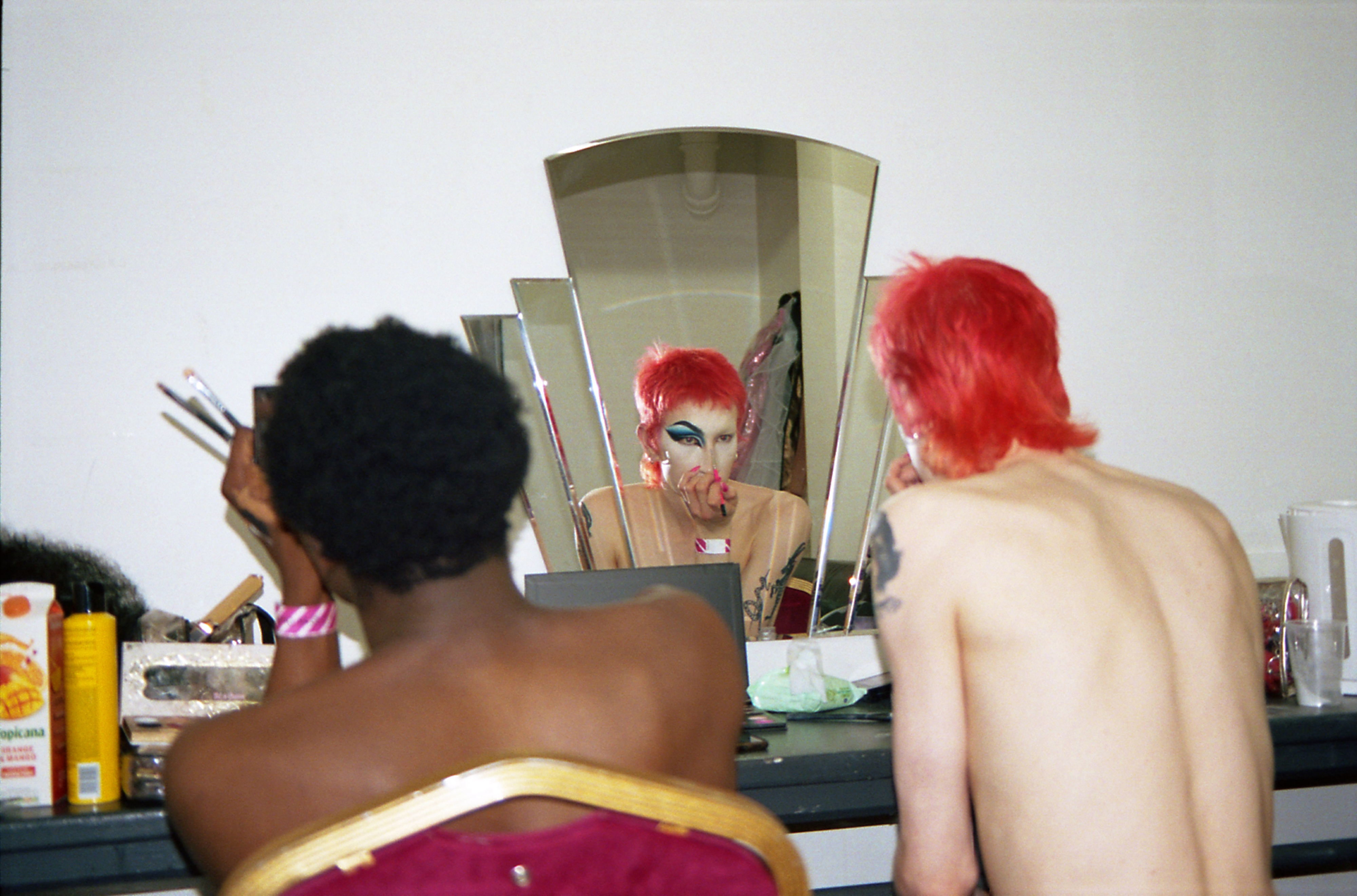
My 4 PM arrival at the Troxy on Saturday, March 30, felt… strange. It’s not often that you enter the venue when it’s light out. I’m here to witness preparations for the spring edition of Sink The Pink (theme: When I Grow Up), featuring the annual Miss Sink The Pink competition. A small stage door down a narrow side street opens into the cavernous space, split across two floors, connected with a spiraling art deco staircases. As we enter, drag queen Taylor Trash, one of the contestants in the annual ‘Miss Sink The Pink’ competition, is onstage. Framed by two blow up legs a la Geri Halliwell’s 2000 Brit Awards performance, four dancers dressed as garbage bins bob along as Taylor Trash careens around the stage, lip-synching to a parody of Aqua’s “Barbie Girl.” Choreographers and dancers stand around watching, while queens and production assistants rush around a lone white dress in the middle of the floor, so voluminous it holds itself up—frozen in motion, the ghost of performances to come.
Miss Sink The Pink has been running since the night’s inception. Each year, a group of contestants is invited to participate. They perform live on the night in front of judges, and one queen is crowned Miss Sink The Pink. Over the years, as with everything Sink The Pink, the spectacle has only grown in size. This year’s competition was to be judged by two Pussycat Dolls, Kele Okereke of Bloc Party, fashion designer Henry Holland, John Sizzle of The Glory, British reality TV star Scarlett Moffat, and Adam Garcia from actual Coyote Ugly. The prizes include gin, sunglasses, Cher tickets, and a performance slot on the main stage of the Mighty Hoopla—a festival held by Sink The Pink that will take place in Brixton’s Brockwell Park in June.
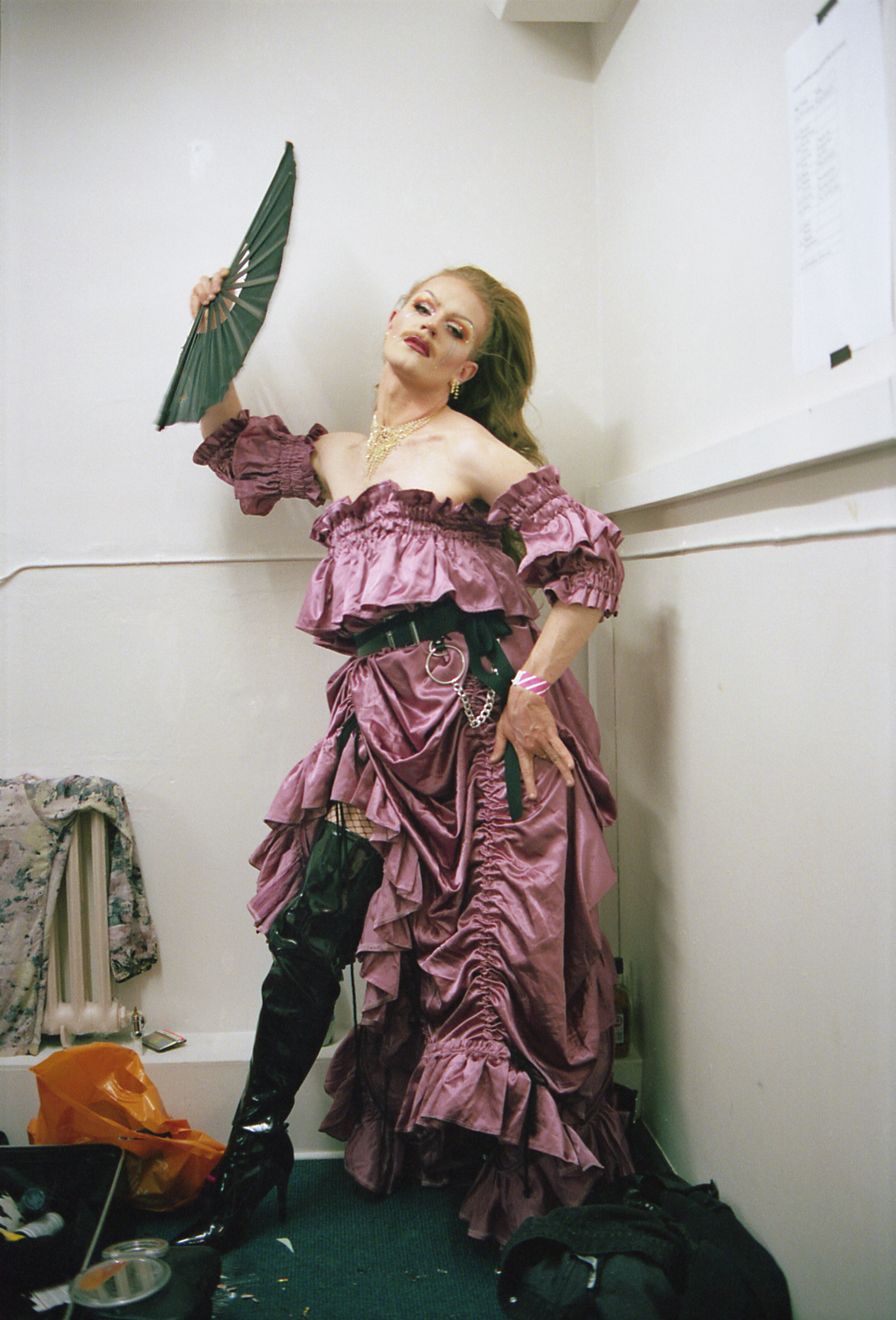
Upstairs, Miss Sink The Pink 2018, Grace Shush, is in her dressing room creating her look for later. “I was borderline obsessed with Sink The Pink when I was living in Norwich, England, and started a club loosely based on it,” she tells me, wearing what she describes as a glittery “potato sack.” It will become a tearaway for her number later. She’s here to perform one last time as Miss Sink The Pink (to Shirley Bassey’s “Big Spender,” of course) and to hand the crown over to the next queen. “I remember screaming ‘fuck off’ and just walking backward off the stage,” she tells me, reliving the moment she took the crown with a lip sync performance of “This Is Me” last year. “I couldn’t believe it; I’ve been doing drag for a while and so it was almost a validation that I’d done well.”
There are still two hours to go until the first performance but already glitter scatters across the floor. One contestant, Bimini Bon Boulash, has just finished stuffing four giant confetti cannons with fake money she’s had her face printed on—colored to exactly match her outfit. In the corner, fellow contestant Crayola is mute, saving her voice for her performance and making wild gestures in the direction of conversation so as to participate. People are stumbling over and around one another, affixing eyelashes, spraying what can only be described as unhealthy amounts of hair and glitter spray around their general person. Someone’s had a disaster involving an entire pot of blush and a breastplate, while down the hallway the whoops, cheers, and sneers of a collection of queers rip around the walls.
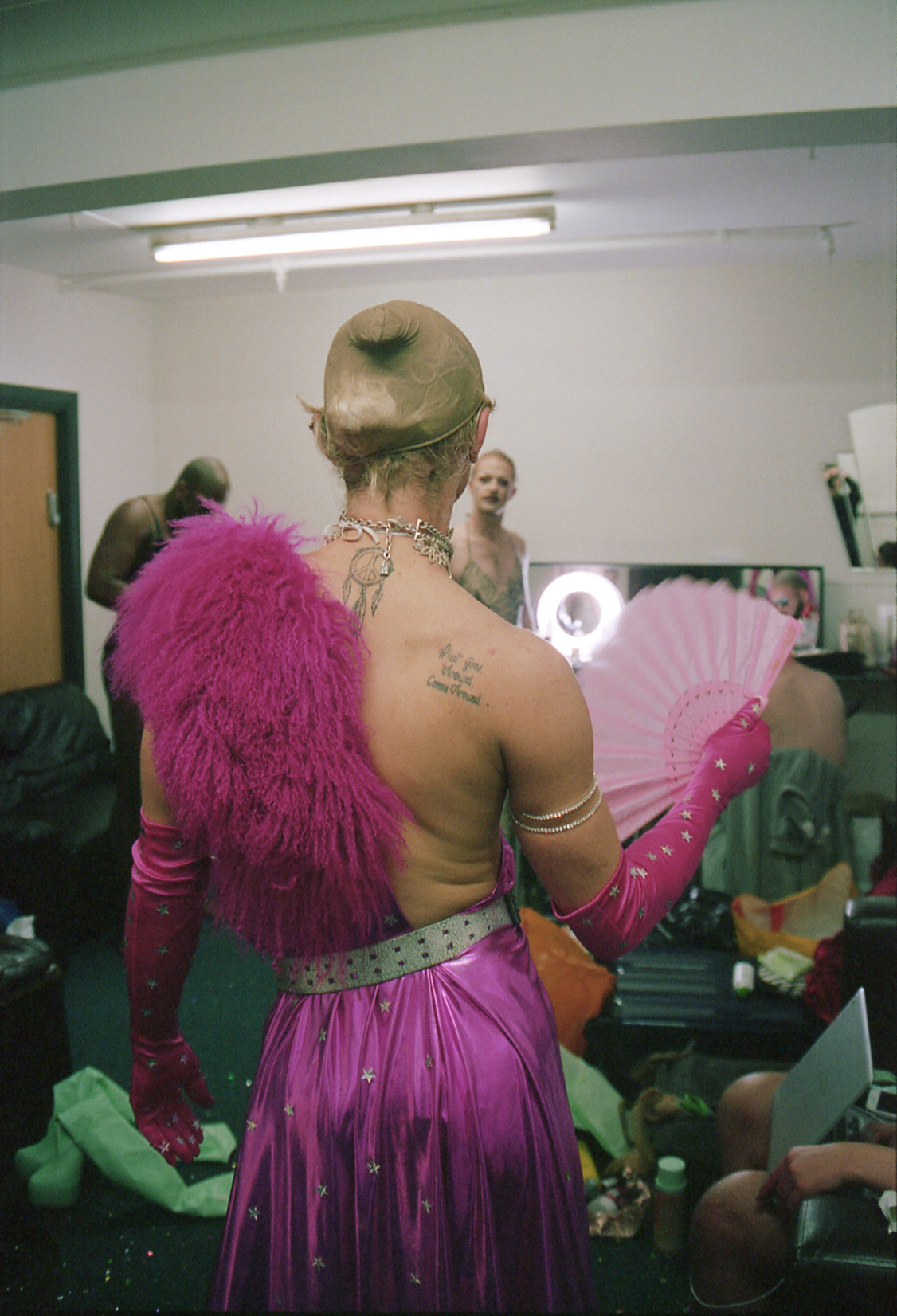
This is the chaos of Sink The Pink in full force. Downstairs, associated queens and hangers-on stumble through the hallways, prosecco bottles in hand. Those due to perform run around, putting the finishing touches to their looks, earphones in, memorizing lyrics and choreography.
On the other side of the stage, the dancehall is filling up with party goers, but the feeling is decidedly more muted—something that’s felt increasingly the case with Sink The Pink as it’s aged and transformed. As the stages have got bigger, the space between show and spectator has grown too.
Sink The Pink exploded onto the scene when east London was changing when drag was changing. Starting in 2008, around the same time both world-famous Dalston Superstore opened and the first season of RuPaul’s Drag Race aired, it arrived as the world economies collapsed, at the beginning of what would become a grueling decade of austerity and hardship. From the offset, Sink The Pink was a place for outcasts—for people in desperate need of a people and a space in an increasingly hostile world, born of a need to escape the commercialization of gay culture. It plonked itself in the center of a counterculture, and never really looked back. Or forward. It just kind of… was.
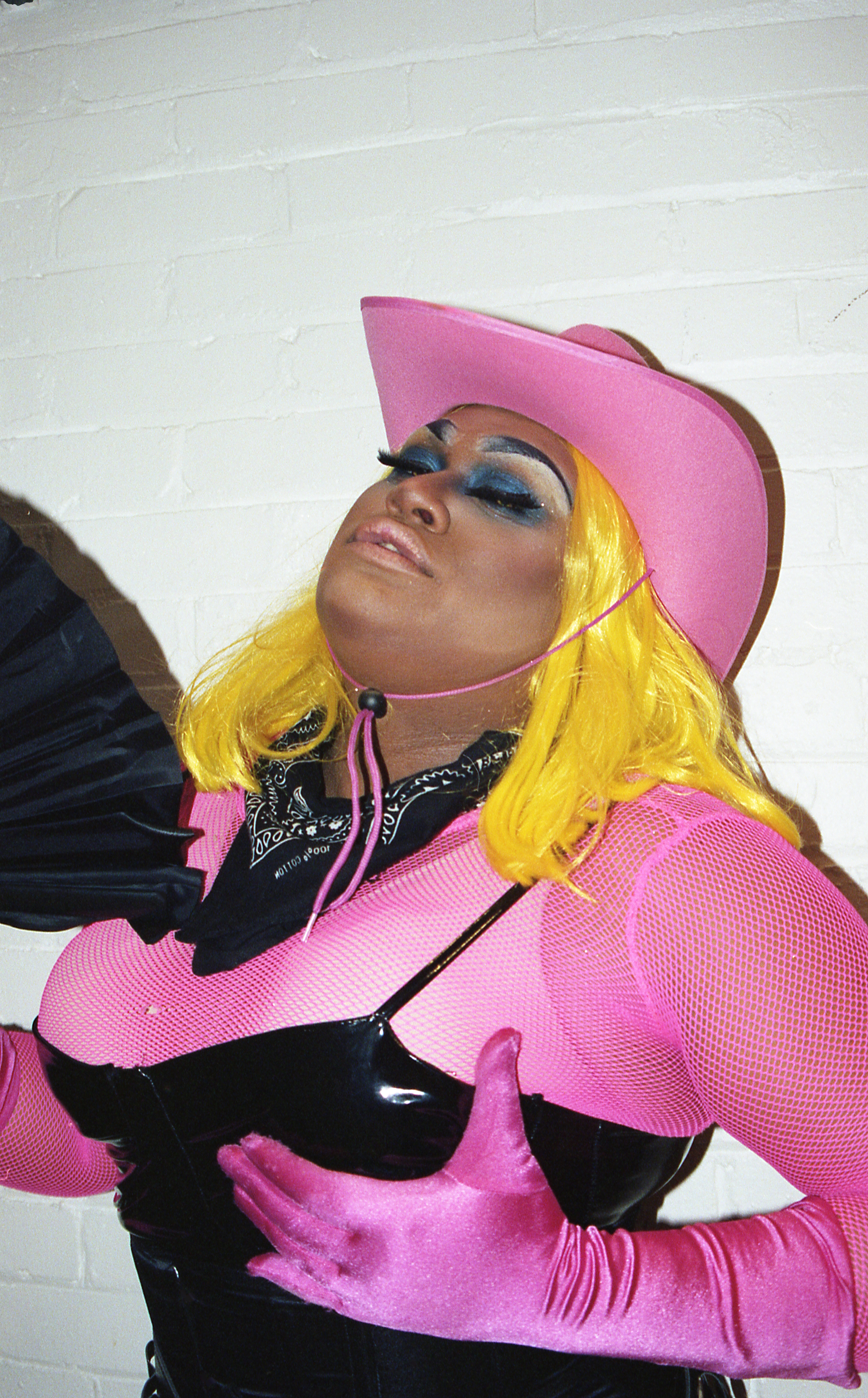
Over a decade later, sitting in one of the many dressing rooms nestled in the rabbit warren around the 3,100-capacity venue, you do kind of wonder whether it’s transcended the counterculture spirit it began with. Barbs doesn’t think so. “It’s like a Skittle,” she tells me. “It’s got that shiny, sleek veneer on it, but underneath there’s still a chewy messy center.”
Still, as the Troxy begins to fill up, it’s only the shiny, sleek veneer that most get to see. The clientele drink and party like they’re in any other big gay club, albeit dressed to the nines, while backstage Dionysus reigns supreme. At last year’s 10th-anniversary street party, this juxtaposition couldn’t have been more clear. In the arena, floral vests and mesh tops danced on the spot with pints in hand, but behind the scenes, an unpublishable series of debaucherous tableaus were painting themselves across the white marquee that formed the dressing room. Moving between the two spaces, it’s hard not to consider whether Sink The Pink has come full circle, morphing into the commercialized beast that it sought to slay.
In 2016, Georgie Bee became the first (and only) female Miss Sink The Pink winner. “A lot of people have an idea of what they want and like from change,” she tells me ahead of this year’s competition. “But now Sink The Pink has such a big, important role in presenting queerness to the masses. You can only prove so much to a person who doesn’t relate or understand, so you have to paint a picture for them to look at and digest—that’s why Sink The Pink has become what it is. It’s got more of a format, more polished than that sweaty, raucous beginning.”
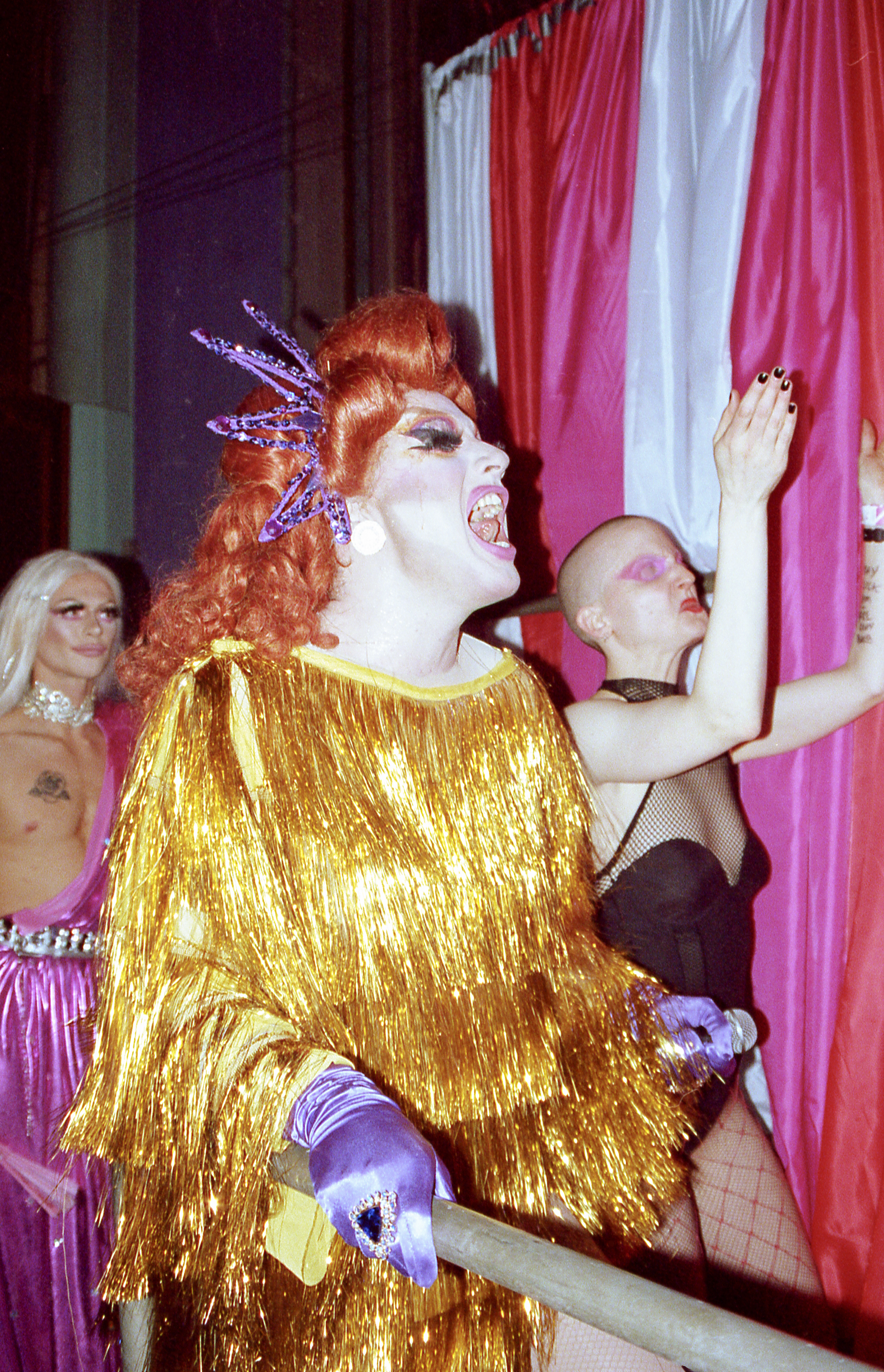
For Lick Von Dyke, the only female drag queen in the competition this year, that platform is an opportunity to question and challenge misogyny within the community. Her piece starts with a news report on RuPaul’s comments about drag losing its danger if women are doing it, before exploding into a fire-laden dance routine.
“It’s so important for people out there to see representations of themselves on stages and screens because that’s how you feel a sense of belonging and connection,” she explains. “This act is my rebellion against RuPaul’s gender politics within drag. A ‘traditional’ drag queen said to me recently that women in drag is ‘going too far,’ so my performance tonight is dedicated to her.”
The need for representation also speaks to fellow contestant Freida Slaves. “I used to come here a lot, years and years ago,” she tells me. “I saw the queens up on stage having a good time, and I always wanted to be part of that. The first time I ever dressed up in drag was here—I looked a bit like a thumb in a wig—and now, tonight, when I walk out on stage, I’m going to be the queen that all those thumbs in wigs look at and think I want to do that. I want to show all the other queers of color that you can do this. I used to think you had to make a choice between being black and being queer because I didn’t see the representation. If I’d have seen myself on stage I would have had fewer questions, been less confused.”
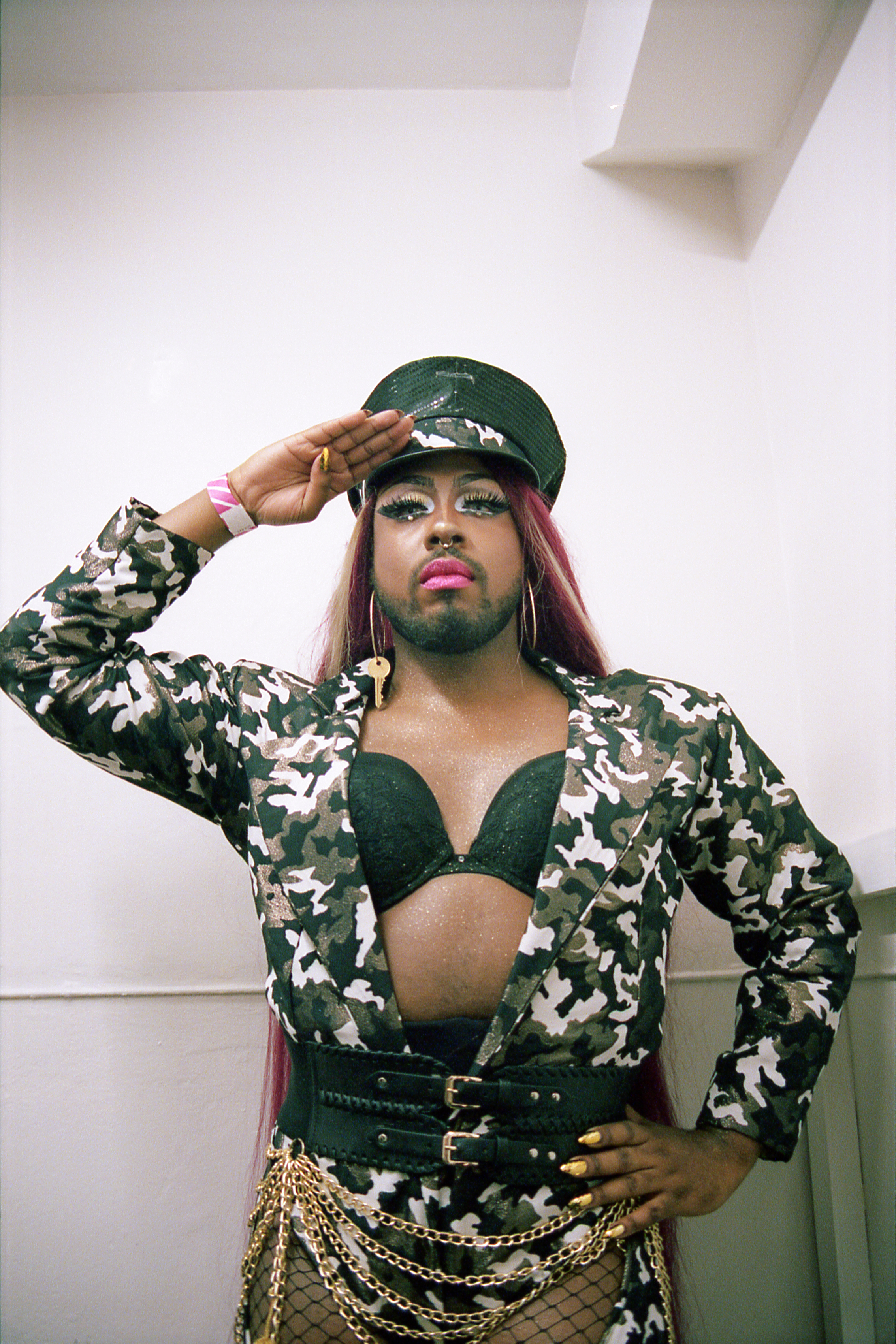
In the early hours of the morning, before we’re due to hear who’ll be crowned, the energy backstage is reaching a fever pitch. Nervous contestants hang around outside, panic puffing on cigarettes as production managers run around shouting timings—“Crowning in ten minutes!” Each queen has changed into a crowning outfit. Bimini Bon Boulash wears a gown made for her by her roommate that day. “I came to drag two years ago with a background of a lot of mental health issues, which came from drug addiction when I moved to London. Now, it feels like it’s come full circle—my mom is going to be here. It’s the first time she will meet me in drag and see me perform. It means so much to do it on this stage.”
Bimini’s performance—a spellbinding slow and sensual piece to Tina Turner’s Private Dancer, which includes an intricate pole routine with a drop from the top into a split—bags her the crown. As it’s announced, host and founder Glyn Fussell directs a spotlight to find Bimini’s mom in the crowd, her friends and family losing their collective shit. It’s a far cry from the formative era of the club, which one queen labeled “the mephedrone years”—a place that was demonstrably non-parent friendly.
“Sometimes I pine for the Working Men’s Club,” Amy Zing tells me later, when we retreat to an upstairs corridor, drinks in hand, to talk about how things got to this point. “I left my heart there in a way. It’s almost like a child that gets famous. You can’t really control it. Sink The Pink is so much bigger than us now.”
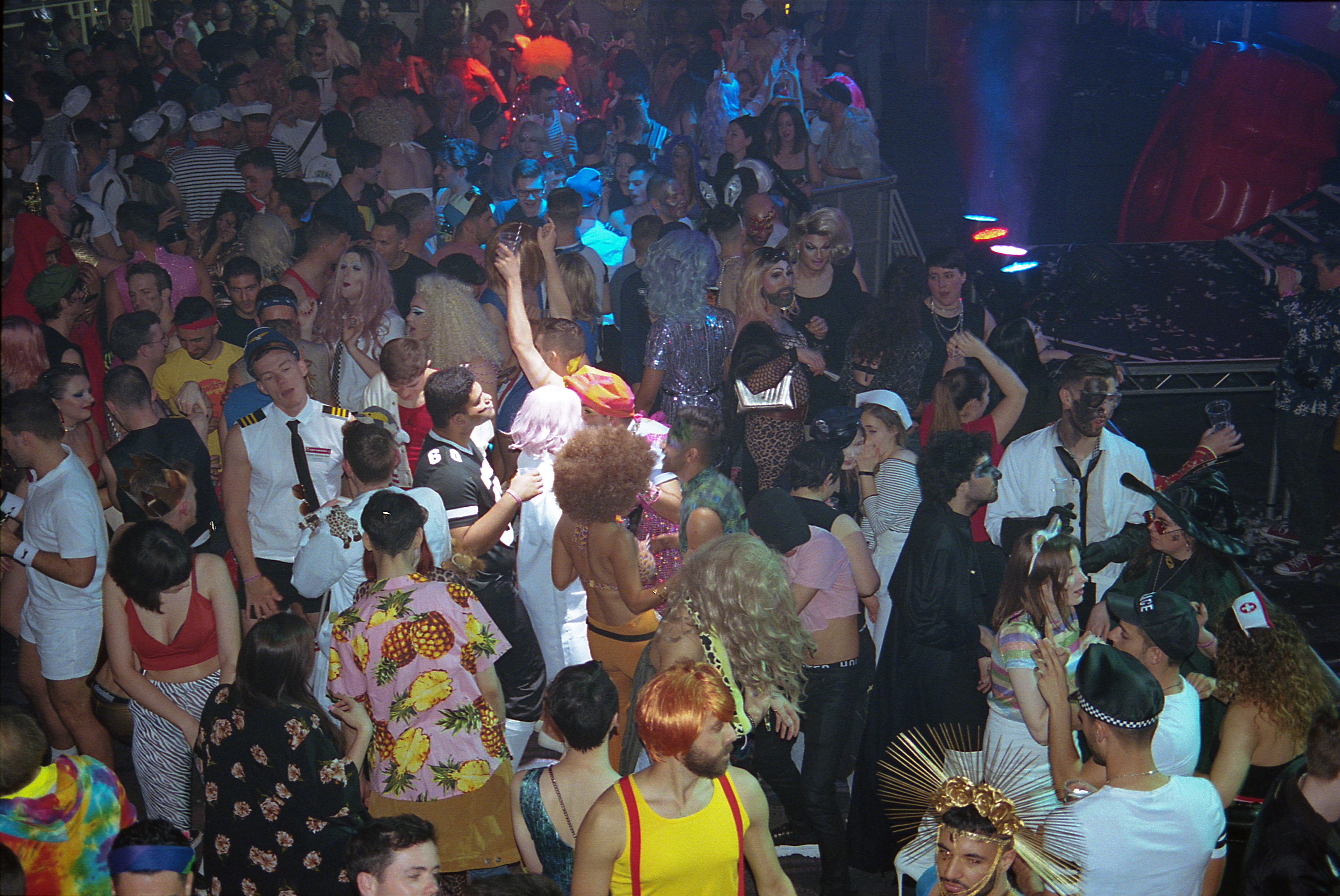
You can’t doubt the sheer scale of the phenomenon. Just a week before, Sink The Pink queens went to perform in Singapore. A world Pride tour with Mel C has just been announced. And last year the Mighty Hoopla was headlined by TLC.
“Of course there may be people from the very early days who may see it as selling out, but what other option do you have when there’s a line of 300 people all in wedding dresses that can’t get into the Working Men’s Club? It was a problem every month, that there would always be people who couldn’t get in, and that broke my heart too,” Zing says. “We want people to have the best night of their lives, and I take that responsibility seriously. The ethos is still there, but of course, it’s bigger. What I used to love about it was when people came up and joined us on stage, and I do struggle with the ‘us’ and ‘them’ of it now. It is a genuine struggle because, in a way, I wish it wasn’t as popular as it is, and yet I’m so fucking proud of it.”
More than a decade later, Sink The Pink is still a spectacle—and an incredible one at that. The time and energy that goes into a single show is mind-boggling. The set team had been in the Troxy for two days before the party. Queens had been rehearsing non stop for a week. Dancers and choreographers, videographers and photographers, production managers and sound engineers spend the day tirelessly working to pull it together. The opening number is a lip-sync performance of The Pussycat Dolls “When I Grow Up,” featuring two of the actual Pussycat Dolls. There’s fire and splits, ensemble dance numbers, films, props, and an almost obnoxious number of reveals—not to mention a pride parade’s worth of confetti. And it all pays off in the end. Sink The Pink is exciting and enthralling, cheers and screams constantly ringing in your ears. The fact that at a ragtag collection of east London queers can reach such a wide audience—an unthinkable feat even five years ago—is undoubtedly something to be proud of.
Drag, in its widest possible sense, is supposed to move you. It’s supposed to displace you, in one direction or another. Whether it pulls up contortions of disgust, feelings of adoration, of deep amusement or amazement, if it welcomes you or makes you question the fundamentals of yourself: It’s there to engage you. For so many of us—the disillusioned, the misfits—that’s what Sink The Pink was. It was a place to move and be moved, a home full of kindred spirits in an increasingly hostile world. Now, that home has leveled up, and thousands of people have come over for dinner.
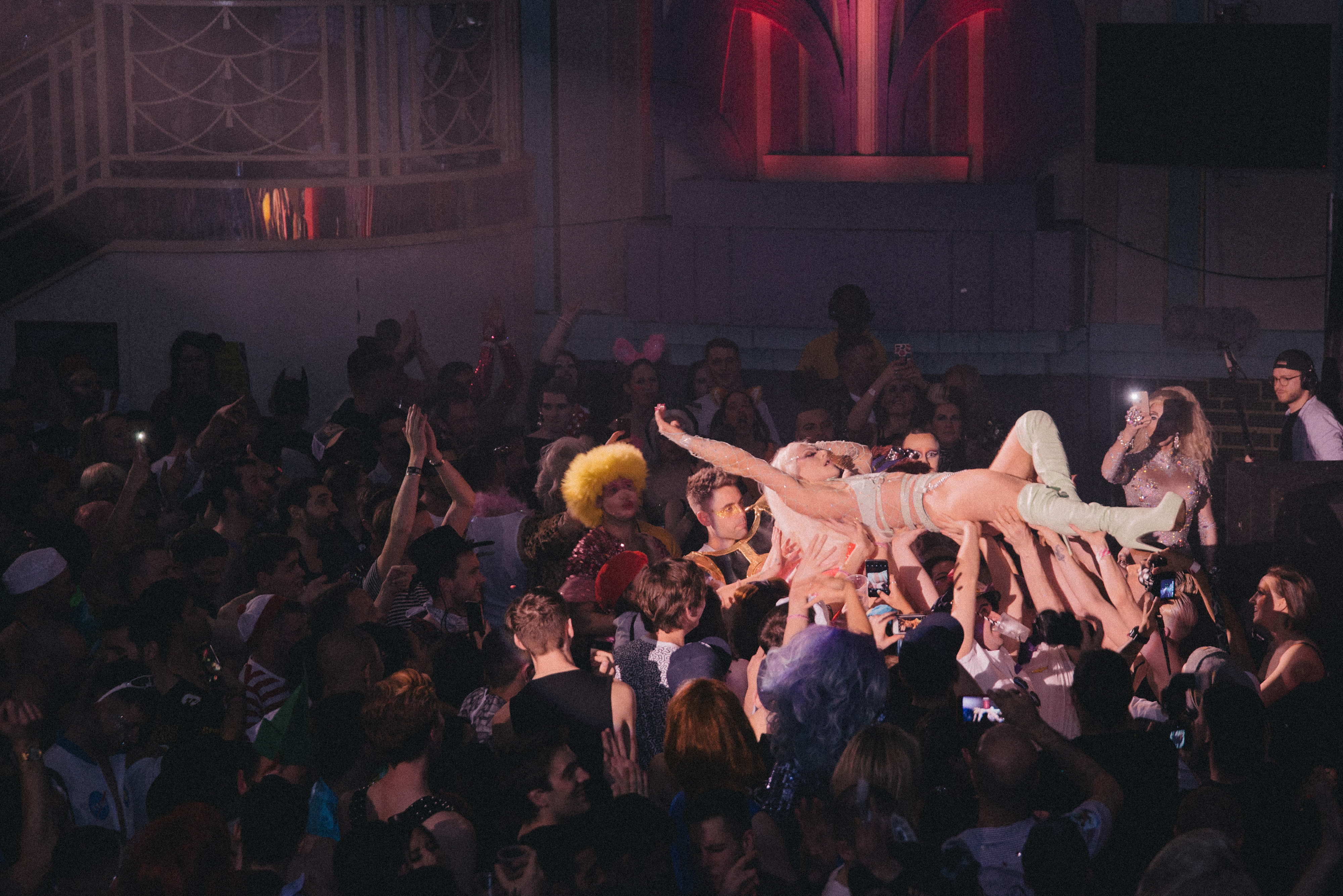
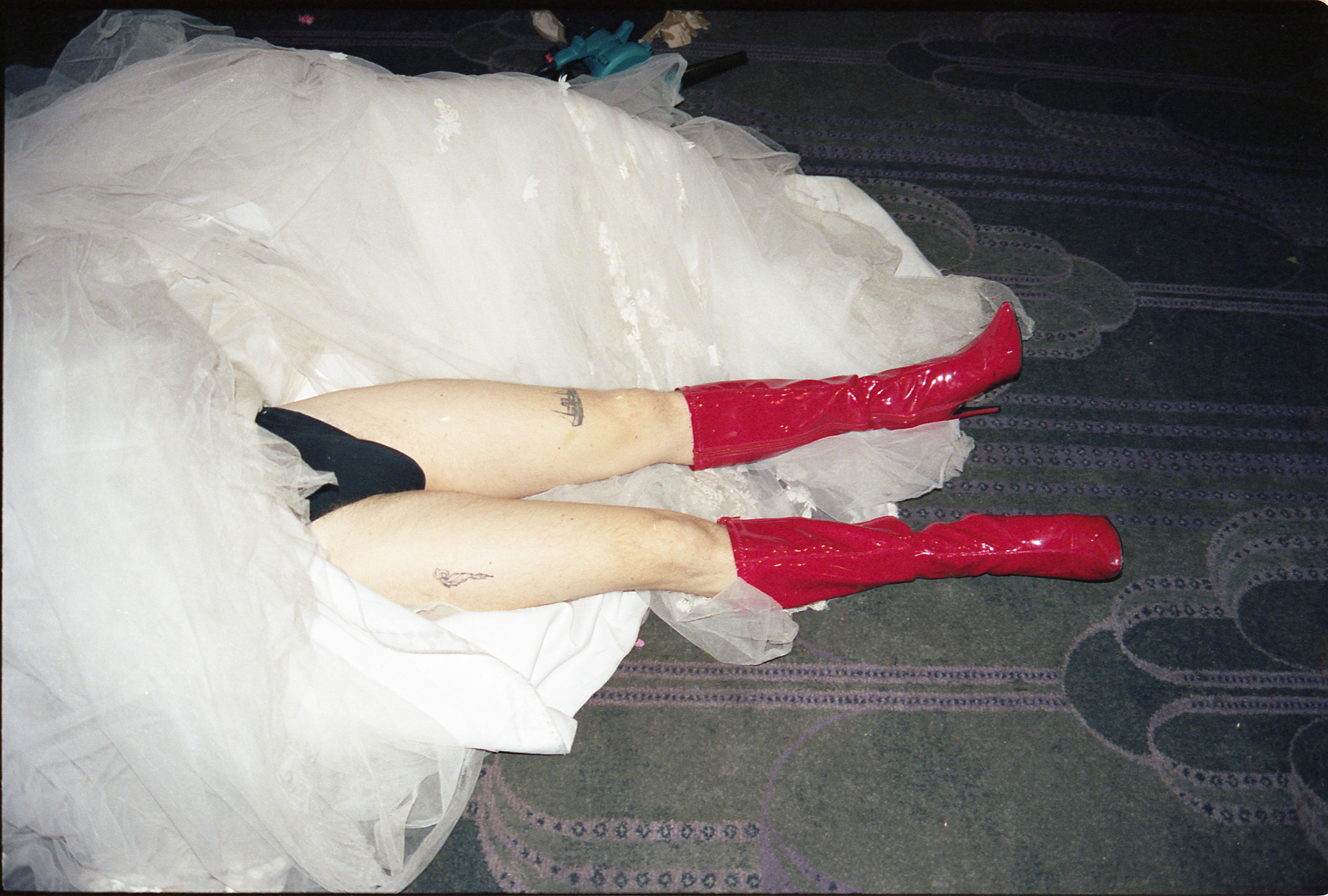
In a way, that’s a good thing. When things change there’s a sense of loss, but putting performers like Lick Von Dyke and Freida Slaves center stage to a crowd not already converted can only be positive. Undoubtedly, there are things to work on. The people walking casually around the crowd in blackface or North American headdresses don’t make for cute looks, and threaten to undermine the representative work done by the queens on stage. Bigger venues, bigger productions, and bigger guests mean higher ticket prices that exclude the poorest in the community, creating an exclusivity that’s antithetical to the ethos of the night. But all that being said, the fact that Sink The Pink even exists and is only getting bigger is overwhelmingly positive.
As we inch closer to Drag Race UK, when the main exposure to British drag for many will be through the sanitized lens of reality TV, the mess and stench of Sink The Pink—with its ability to reach those same people—is a welcome antidote. Most importantly, behind it all, the specter of that Bethnal Green heart—that unpublishable ball of flashes, glitter, drag, and debauchery—still beats indefatigably. Bringing the party, every single time.
This article originally appeared on VICE UK.
Sign up for our newsletter to get the best of VICE delivered to your inbox daily.
Follow Ben Smoke on Twitter.
This article originally appeared on VICE UK.